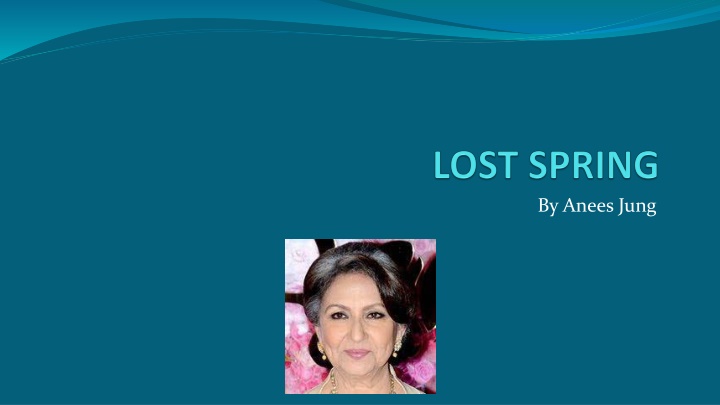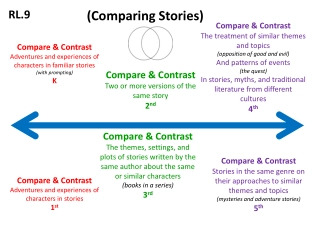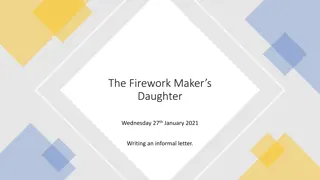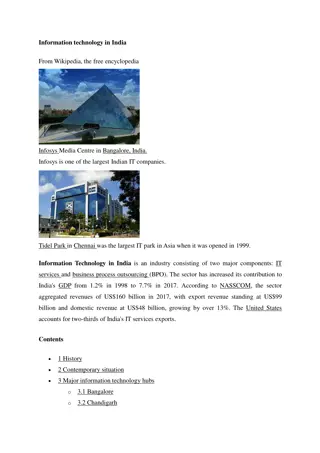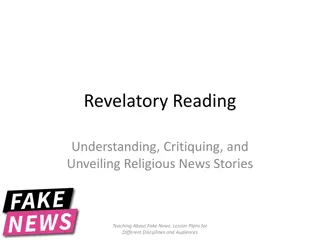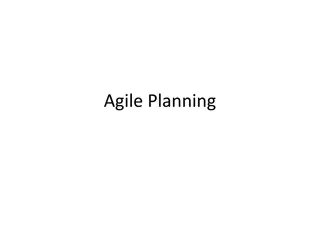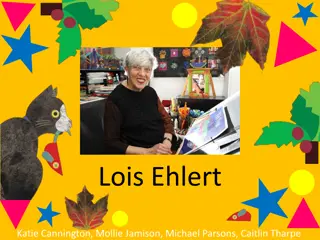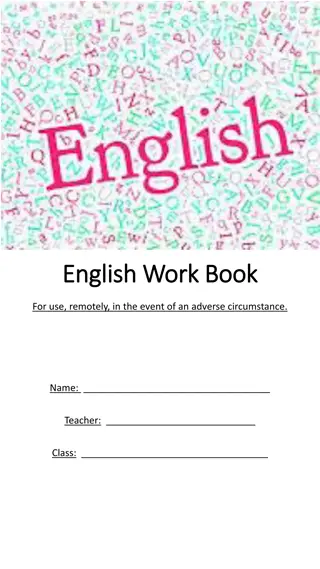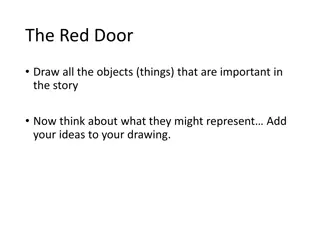Unveiling India: The Author and Her Stories
Anees Jung, an Indian female author and journalist, sheds light on the harsh realities faced by underprivileged children in her story "Lost Spring." She emphasizes the importance of education to end child labor and exploitation, urging society to let children enjoy their innocence. The narrative introduces characters like Saheb-e-Alam and Mukesh to depict the struggles of these children. Jung's powerful storytelling brings to light the desolation and hardships experienced by those living in poverty, urging readers to address socio-economic issues that deprive children of their childhood.
Download Presentation

Please find below an Image/Link to download the presentation.
The content on the website is provided AS IS for your information and personal use only. It may not be sold, licensed, or shared on other websites without obtaining consent from the author.If you encounter any issues during the download, it is possible that the publisher has removed the file from their server.
You are allowed to download the files provided on this website for personal or commercial use, subject to the condition that they are used lawfully. All files are the property of their respective owners.
The content on the website is provided AS IS for your information and personal use only. It may not be sold, licensed, or shared on other websites without obtaining consent from the author.
E N D
Presentation Transcript
About the Author Anees Jung is an Indian female author, journalist and columnist who writes for major newspapers in India and abroad. She was born in Rourkela and belongs to an aristocratic family in Hyderabad. Her father, Nawab Hoshyar Jung, who was a renowned scholar and poet, worked as the musahib (adviser) to the last Nizam (prince) of Hyderabad State. And her mother and brother are also well-known Urdu poets. Jung hit the headlines with the publication of Unveiling India in 1987 , which is primarily a travel diary that focuses on interviews with women. She went on write many subsequent books on the same topic, and talked to women about their everyday lives, and wrote books like Night of the New Moon: Encounters with Muslim women in India (1993) and Seven Sisters (1994). Her book Breaking the Silence (1997) includes conversations on women s lives from around the world.
Introduction The story, Lost Spring describes the pitiable condition of poor children who have been forced to miss the joy of childhood due to the socio- economic condition that prevails in this man-made world. These children are denied the opportunity of schooling and forced into labour early in life. Anees Jung gives voice to eliminate child labour by educating the children and to enforce the laws against child labour strictly. The call is to end child exploitationand let the children enjoy the days. Characters: Saheb-e-Alam: Mukesh: A rag picker Son of a bangle maker
Vocabulary Scrounging searching for Glibly - speaking orspoken in a confidentway, but withoutcareful thought or honesty Hollow meaningless Embarrassed - feeling ashamed abound - exist in large numbers bleak empty perpetual state of poverty - never ending condition of being poor Desolation - the state of being empty Panting - taking short and quick breathes
Desolation - the state of being empty Panting - taking short and quick breathes Acquaintance - contact periphery- outer area metaphorically symbolically squatters - a person who unlawfully occupies an uninhabited building or unused land wilderness- a wasteland tarpaulin- heavy-duty waterproof cloth Transit homes a temporary home looms like a mirage - seems that it will be true in the future but actually it will not be so
Hovels slums Crumbling falling down Wobbly unsteady Coexisting - present at the same time and place Primeval prehistoric Bangs hits Shack a roughly built hut Thatched covered with dry grass Vessel container for cooking food Sizzling - make a hissing sound when frying or cooking Platters large plates Chopped cut finely Frail thin, weak Impoverished very poor God-given lineage - here, a profession carried on through the generations of a family glass bangle making
Unkempt not taken care of Shanty town - a town that is full of small, roughly built huts Drab faded, colourless Sanctity - the state of being sacred or holy Draped covered Vicious cruel Hauled up dragged, taken away Apathy lack of concern Stigma dishonor Hurtling down moving around
Summary (Part I): Sometimes I Find a Rupee in the Garbage - Saheb-e-Alam (A rag picker) The first part tells the writer s impressions about the life of the poor rag pickers. The rag pickers have migrated from Dhaka and found a settlement in Seemapuri (India). Their fields and homes had been swept away by storms (Socio Political Unrest). They had come to the big city to find a living. They are poor. The writer watches Saheb every morning scrounging for gold in her neighbourhood. Garbage is a means of survival for the elders and for the children it is something wrapped in wonder. The children come across a coin or two from it. These people have desires and ambitions, but they do not know the way to achieve them. There are quite a few things that are unreachable to them, namely shoes, tennis and the like. Later Saheb joins a tea stall where he could earn 800 Rupees and all the meals. The job has taken away his freedom.
Part II I Want to Drive a Car Mukesh: Son of a bangle maker The second part deals with the life of Mukesh, who belongs to the family of Bangle-makers. Firozabad is best known for its glass-blowing industry. Nearly 20,000 children are engaged in this business and the law that forbids child labour is not known here. The living condition and the working environment is a woeful tale. Life in dingy cells and working close to hot furnaces make these children blind when they step into the adulthood. Weighed down by the debt, they can neither think nor find a way to come out of this trap. The politicians, middlemen, policemen and bureaucrats obstruct their ways of progress. The women in the household consider it as their fate and just follow the tradition. Mukesh is different from the rest of the folk there. Hedreams to becomea motor mechanic.
Gist: (Sometimes I find a rupee in garbage) The author examines and analyses the impoverished conditions and traditions that condemn children to a life of exploitation these children are denied an education and forced into hardships early in their lives. The writer encounters Saheb a rag picker whose parents have left behind the life of poverty in Dhaka toearn a living in Delhi. His family like many other families of rag pickers lives in Seemapuri. They do not haveother identification other than a ration card. The children do not go to school and they are excited at the prospect of finding a coin oreven a ten rupee note forrummaging in thegarbage.
It is the onlywayof earning. The writer is pained to see Saheb, a rag picker whose name means the ruler of earth, Lose the spark of childhood and roams barefooted with his friends. From morning to noon the author encounters him in a tea stall and is paid Rs. 800 He sadly realizes that he is no longer his own master and this loss of identityweighs heavilyon his tendershoulders.
I want to drive a car The author then tells about another victim, Mukesh who wants to be a motor mechanic. He has alwaysworked in the glass making industry. They are exposed to various health hazards like losing their eyesight as theywork in abysmal conditions, in dark and dingy cells. Mukesh s father is blind as were his fatherand grandfather before him. So burdened are the bangle makers of Firozabad that they have lost their ability todream unlike Mukesh whodreams of driving a car.
Useful Links: https://www.youtube.com/watch?v=lNwsoEPyjcM https://www.learncbse.in/ncert-solutions-for-class-12-flamingo-english- lost-spring/ https://edunation19.blogspot.com/2019/10/lost-spring-summary-class-12- ncert.html
